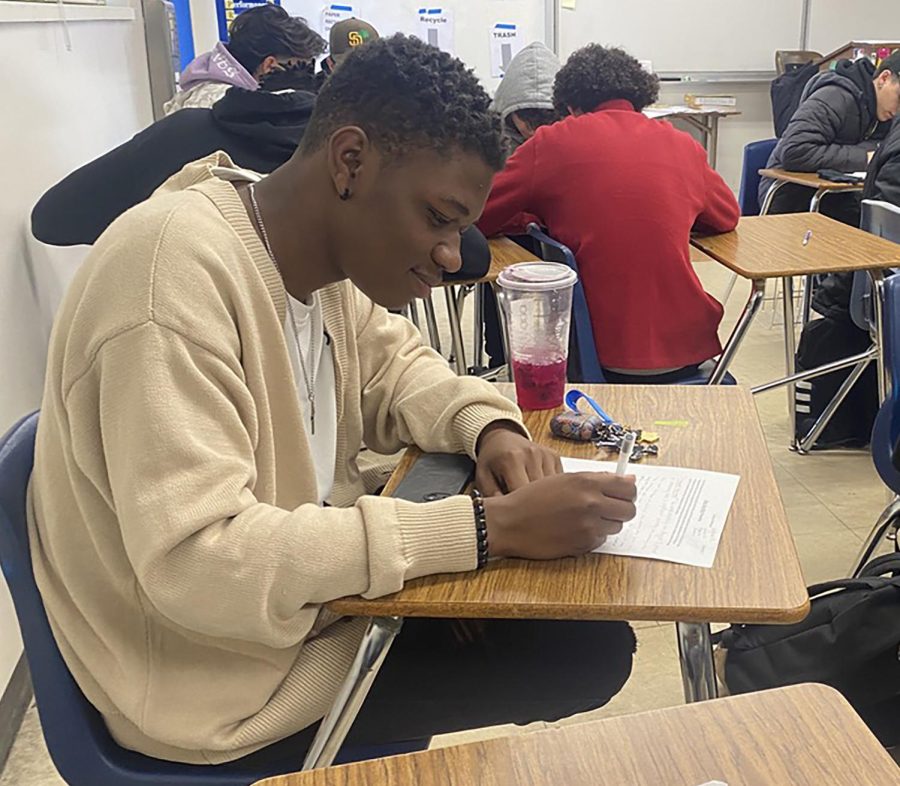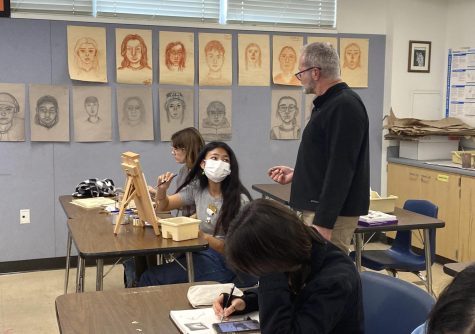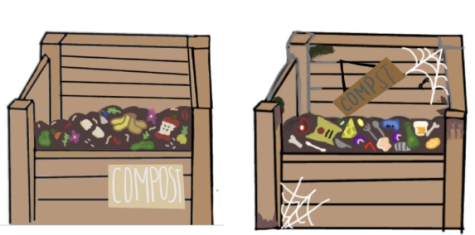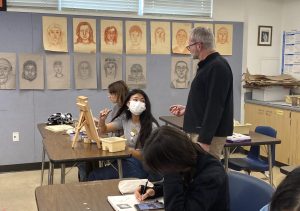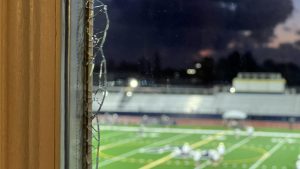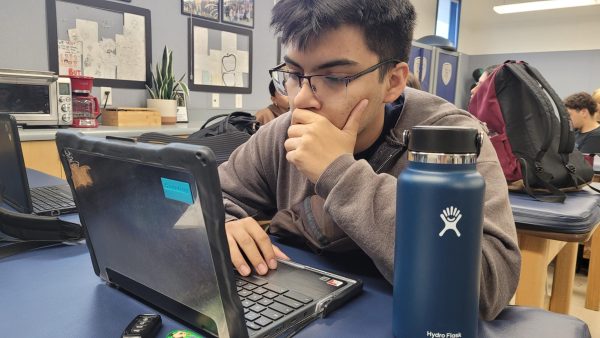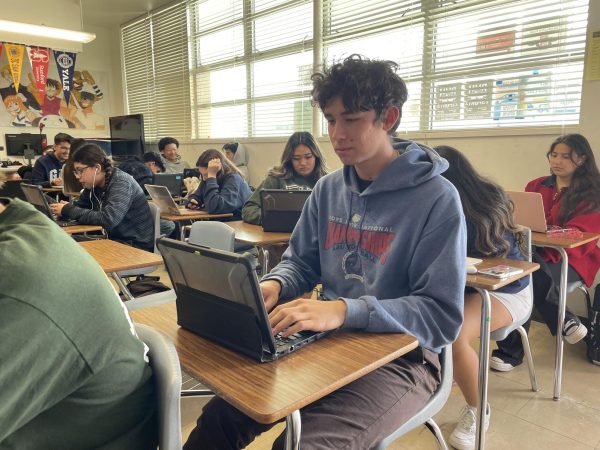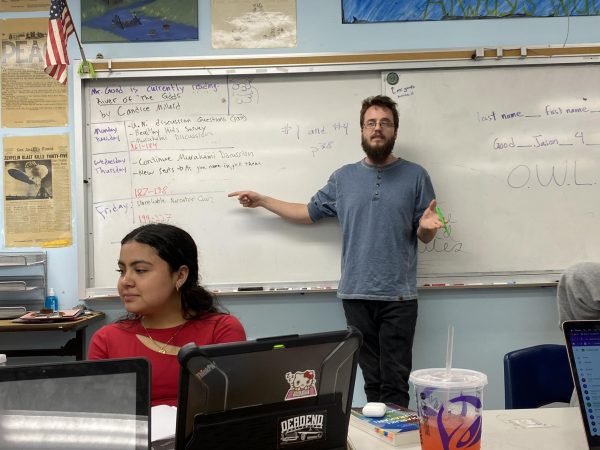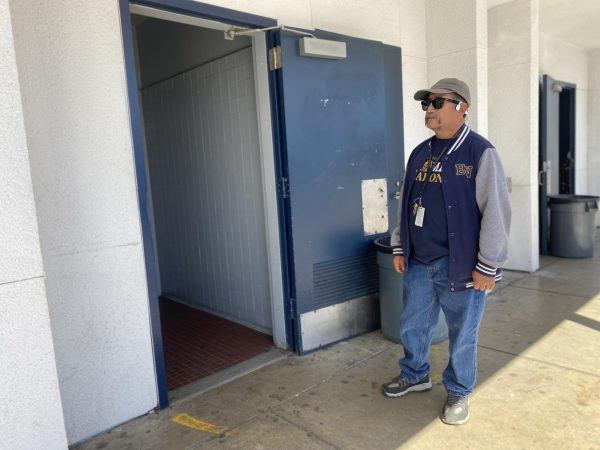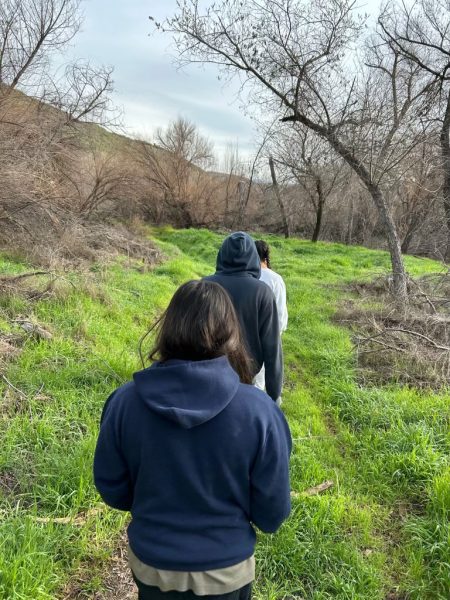All hands on deck
Combatting youth homelessness takes community effort
On Feb. 23, Gladney works on an assignment in his first period English 12 class in room 405. Gladney’s assignment is to work with a select group and to write a new ending to the book “Into the Wild.”
At Bonita Vista High (BVH), 14 of the 330 students surveyed in a poll conducted by the Crusader have experienced or are experiencing homelessness. Many students in the poll remained anonymous and did not want to be interviewed for this article, except BVH senior Jaylen Gladney.
Towards the end of 2022, Gladney received the news that he had to move with his family to Texas, even though it was a few months into his senior year here at BVH. He had lived in Texas during his sophomore year and experienced what it was like to live there. Gladney explains how it did not suit him and he was struggling mentally that year.
“Two years ago, I had already experienced living in Texas with my parents because my dad is in the military and we move around sometimes. To be straight forward, I didn’t like it at all,” Gladney said. “It was very different from California and I wasn’t a fan. I was so excited when I got to come back and live here in Chula Vista with my grandma.”
Gladney was fortunate enough to come back and live with his grandma and uncle for the past two years. But in October of 2022, his grandma informed Gladney that she was moving to Texas with Gladney’s parents and Gladney would have to go back with them. Gladney expressed how he did not want to go back, so he chose to find different solutions. He contacted all of his friends to see if he could move in with them, so he could finish his senior year at BVH. He explains how this process was a struggle and was concerned about whether he was able to stay in Chula Vista.
“When my grandma first told me, I got frantic and didn’t know what to do. It was a short notice and I had about a month to figure out what to do,” Gladney said. “But luckily, I asked my closest friends to see if I could stay with them and after a few rejections because of my friend’s parents—which I understood completely—I was able to find a friend that finally agreed to let me stay with them.”
After finding a friend to stay with, on Nov. 15, Gladney had to move all of his belongings to his new temporary home, along with having to adapt to his new lifestyle. For a couple of months, he adjusted and respected the expectations of his friend’s parents. This was a struggle for Gladney since it was very different from what he was used to in his previous home.
“[My friend’s parents] told me that they are going to treat me like I am their own kid. So, I had to follow their 9:00 p.m. curfew time and 10:30 p.m. bedtime, which was very different from my usual routine since I never had a curfew,” Gladney said. “I also have to help out with some chores around the house.”

Other than receiving help from his friends, Gladney also explains how he reached out for help at the school. He talked to his counselor Rosa Tovar and contacted the Assistant Principal Esther Wise. He wanted to keep as many options open as possible and see if he could get help with transportation. Gladney does not own a personal vehicle for transportation, which was a challenge since he had a job next to the school–which is 25 minutes away by walking–from his friend’s home.
“I decided to talk to Tovar and Wise to see if I could get any resources or any shelter homes, just in case I couldn’t find a place to stay. I turned 18 in November, so the process was a little harder, but they were able to provide me with a bus ticket so I can have free transportation to school and back home,” Gladney said. “They also offered me some socks, but I declined because I have enough and I would rather them give it to another student who may be completely homeless and less fortunate than me.”
To help himself financially, Gladney had a job across the street from BVH at Tapioca Express—a Taiwanese-American fast food franchise chain specializing in drinks and snacks. He had been working there a couple weeks before he was homeless, meaning that he had some money saved up from the job already. Gladney, unfortunately, quit a few weeks ago due to complications with his manager, causing him to look out for a new job.
“I worked at Tapioca Express for a few months to save up some money and feel financially independent in a way. I’m not expected to pay any bills, but I have to keep a job in order to pay for fun things like Netflix and HBO Max,” Gladney said. “It was a difficult decision to quit because I need the money, but I am currently looking for other jobs close to the school.”
In general, Gladney received help at BVH, but there are other various sources in San Diego for those experiencing a similar situation. South Bay Services, Youth for Sustainable Future (YFSF), police departments and even staff members at BVH provide resources and help homeless students. South Bay Services volunteer Louise Escevas explains what the South Bay Services do to help.
“[South Bay Services] comes to the schools to put the food that has been used into compost. So I think that they are doing a tremendous job of teaching people self worth, teaching people the future, teaching people how to be self sufficient,” Escevas said.
South Bay Community Services does collaborate with other resources such as YFSF, where they provide available resources to homeless individuals and families. Founder and Executive Director of YFSF Tina Matthias explains the benefits that come with working with the programs.
“We’re working to help make those shelters as well as those communities more sustainable. We’re working with Macalester, which is a nonprofit organization that teaches homeless people how to get into the workforce,” Matthias said. “There are many organizations that are working. As long as we all collaborate together, it could be much more successful.”
Alongside local programs, the Chula Vista Police Department (CVPD) plays a part in providing assistance when they encounter homeless individuals. Homeless Outreach Center (HOC) Officer Carly Schoch explains what she does when she encounters a homeless person, specifically minors.
“[When we encounter homeless people that are minors], we try to get to the root of the problem of why they ran away or feel like they need to be out on their own. [We] try to work with the minor and their parents or guardians to resolve the issues,” Schoch said.
Later on, if an issue cannot be resolved within the minor, they will most likely end up at Polinsky Children’s Center—an emergency shelter for children—or other alternatives. The CVPD is instructed to follow the procedure when it comes to encountering minor homeless people. Divisions in the CVPD, such as the HOC, help the community by creating ways to solve the issues within homelessness. Escevas explains what will happen to the minors once they are escorted to a shelter.
“Police will say to them, ‘You can go to a center that’s your age group.’ They’re set up with a dorm, their own games, people the same age as them and it’s a lot more comfortable. If they’re an older child with a younger child, they don’t ever separate them,” Escevas said. As teachers, we’re not really looking out for signs that a student is struggling with something like [homelessness]. We’re usually talking about getting through the curriculum, the content. — BVH Principal Lee Romero
At BVH, multiple steps are taken to establish a strong relationship with a student who is registered under the school’s system as homeless. Not only do staff members including Targeted Support Resource teacher Michele Godoy and BVH Principal Lee Romero look for alternatives and solutions, but they make sure students have access to basic necessities.
“I check in [with the homeless students], whether they need school supplies or resources. I usually don’t ask them personally because they’re very shy. Most of them don’t want to admit that they need some things, but we make sure that they have the resources,” Godoy said.
Some staff members do provide additional help with school related topics, but BVH as a school gives homeless students the access to simple necessities, such as food.
“Students that are qualified as experiencing homelessness automatically qualify for a free or reduced lunch at school sites. It is critical that students are identified so our district is able to offer this service for free or reduced meals,” Program Manager for Foster & Homeless Youth Education Services Elvia Estrella said.
Furthermore, Matthias verifies that the Chula Vista community has an abundance of departments that help out in different situations. If families do not have food, shelter or other necessities, South Bay Community Services provides numerous opportunities for students who are struggling.
“The City of Chula Vista is creating a homeless awareness department and task force so that they can go out and help students and families that need food or shelter. There’s also all the food drives listed in the City of Chula Vista. These are all resources that students can go to,” Matthias said.
Along with the many material resources provided by the city and SUHSD to students, academic support from teachers and staff are also key to ensure that homeless students at BVH are stable academically. One way BVH staff members support homeless students is through closely monitoring their grades to look for signs of instability. Godoy explains the way she monitors students’ academic performance.
“I call them into my office as part of my role, monitoring them. I try every quarter. I’m always behind the screen and looking at their grades, their citizenship, overall. Any notes on the system, if there’s any issues going on, I call them in immediately,” Godoy said.
In addition to academic support, emotional support is another way staff members assist homeless students. One way that Godoy supports her students emotionally, is through meeting with them individually to discuss their feelings. Godoy shares that when students receive this support from teachers, it reflects in their academic success.
“I meet with them individually, every quarter, about two weeks before progress reports come out and talk to them, check in to see how they’re doing,” Godoy said. “I’m hoping and assuming they’re receiving emotional support in class with teachers. And they’re really good teachers, because I see it behind the screen, otherwise they wouldn’t have good grades overall.” I think that we need to do more listening. We need to do more caring for other people. We need to be non judgmental. When somebody’s having a hard day, it’s not up to us to judge them. — South Bay Services volunteer Louise Escevas
While emotional support is important, not all students are able to receive it if they feel uncomfortable with approaching and communicating to the staff members. Godoy explains that this is why it is crucial for staff members to make an extra effort to check in with students.
“They’re not gonna come and say ‘I’m having a hard time’. So that’s why we make sure we monitor and check on them knowing that there’s space here if they’re having a hard day,” Godoy said.
Another staff member who has worked closely with students facing homelessness is BVH Principal Lee Romero. Romero formerly worked as a counselor at Southwest High, where he worked with homeless youth. He shares that counselors are especially equipped to work with homeless students because of the personal connections they can make with students.
“When I was a counselor, I would deal with kids that were going through homelessness. Counselors are in the perfect position to get to know their kids and the struggles that they might have. So that, to me, would be the very first line of defense in taking care of these kids that are going through those issues,” Romero said.
Godoy and Romero—who both have counseling experience—are knowledgeable in working with homeless students, so that they can support them. However, this is not the case for all staff members, such as teachers. Romero explains that homeless students may not be able to receive proper emotional support from teachers, as teachers are not trained to identify when students are struggling.
“As teachers, we’re not really looking out for signs that a student is struggling with something like [homelessness],” Romero said. “We’re usually talking about getting through the curriculum, the content. It takes experience to see a kid that maybe had good grades and now they’re dropping or they become defiant and things like that.”
To take a step closer in helping resolve the issues with homelessness, Schoch believes that it is imperative to understand the causes of homelessness and provides insight into some of the causes that may lead to homelessness. She gives insight into what can occur to make someone end up homeless.
“It can only take one event: a break up, job termination, death of parent and a lack of being prepared to end up homeless,” Schoch said.
To emphasize how crucial homelessness is, the community must understand the significance of the young generation because facing homelessness as a minor translates into that student’s future. As a South Bay Services volunteer, Escevas mentions that society should start being understanding of those who are homeless.
“I think that we need to do more listening. We need to do more caring for other people. We need to be non judgmental. When somebody’s having a hard day, it’s not up to us to judge them,” Esceves said.
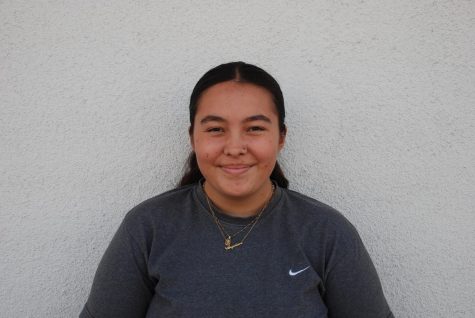
I am a senior at Bonita Vista High and this year's Editor at Large for the Crusader. This is my fourth year on staff, last year being an Arts and Cultures...
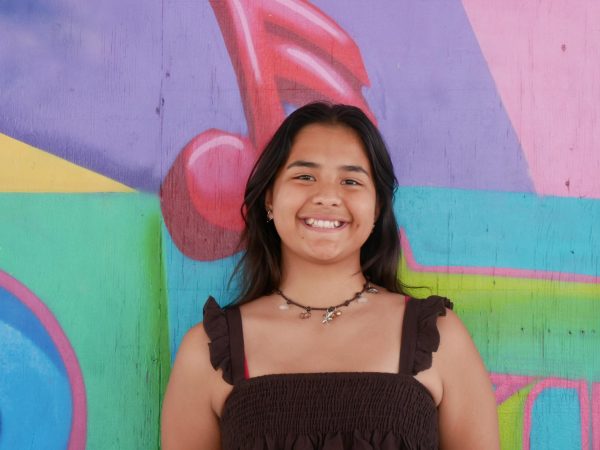
I am a sophomore and am currently the News Editor for the student-run newspaper publication, the Crusader and previously worked as an Opinion Editor. I...

I am a sophmore at Bonita Vista High and this is my second year on staff for the Crusader. This year I am an Arts and Culture Editor and was previously...

